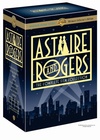


Ginger Rogers and Fred Astaire
Filmography | Lyrics | Articles | Awards | Downloads | Bibliography | Goofs | Statistics | Rankings | Links | Image Credits | Ginger Rogers | Fred Astaire
| Article 5 |
Sixty Million: Three-Fourths of America's Film Fans Like Rogers-Astaire Dancing TeamThe Literary Digest, September 12, 1936 page 17-18The 80,000,000 persons who weekly jam the motion-picture theaters of the United States by this time are divided into two clearly defined groups: There are approximately 60,000,000 who can't keep away from a Ginger Rogers-Fred Astaire picture, only 20,000,000 who won't be drawn to see one. Through a remarkably efficient series of wall-paper plots expressly designed to give the nimble pair an opportunity to dance and utter a few impertinent songs, the two have remained together as a cinema team. Their newest adventure is "Swing Time," an RKO-Radio picture. Nothing detailed ever is done about story or characterization in the Rogers-Astaire films. So long as Miss Rogers has a chance to annoy Astaire in the early reels and he has a chance to wear top hat and tails in three out of the eight reels, nothing else matters. The sketchiest story intervenes. Simple Formula-- It is no different with "Swing Time." He is a professional dancer with a fondness for gambling. She is a pupil in a dancing-school . She resists him for the carefully selected number of reels, dances with him in three others. They arrive at a happy ending. It's as simple as that and usually costs about $600,000 to make into a motion picture. This is the funniest of their teamed films. The hilarity is supplied wholesale by Helen Broderick and Victor Moore. On gay occasion the joking becomes impudently ribald, but there is nothing to frighten a censor in any of it. Camera trickery is used with more abandon, and considerably more forethought, in "Swing Time" than in previous items but the dancing stars. An elaboration of the dancing cut-out figure in "Gay Divorcée," which threw a waltzing shadow on a wall, is used for the most exciting scene in the picture. Pace and Rhythm-- Astaire, while dancing, seems to be throwing Gargantuan shadows of himself against a background. They keep exact page and rhythm with him, their coat-tails fly out exactly as his. Suddenly, the shadows dance off the screen, leaving him to dance alone. Audiences in key cities to which the film was released first have been more than usually breathless in the acceptance. In New York, the critics were unanimous in rating it a superb, if fluffy, item: Kate Cameron, New York Daily News: "Swing Time" . . . is funnier than any of the five costarring films that have preceded it." Howard Barnes, New York Herald Tribune: "Dancing and singing at the very top of their superlative form and clowning magnificently through interludes of merry nonsense, they distinguish themselves anew as the screen's most engaging musical comedy team." |
Article 1 | Article 2 | Article 3 | Article 4 | Article 5 |
| Current Contest Prize: |
|---|
| Now in Print! |
|---|
| Now on DVD! |
|---|
Buy Videos & DVDs |
|
Buy Movie Posters |
|
Buy Movie Posters |
|
Classic
Movie Merchandise |
|
![]() Printer-friendly version.
Printer-friendly version.
![]() Return
to the top.
Return
to the top.
Last updated:
December 16, 2008.
Reel Classics is a registered trademark of Reel Classics, L.L.C.
© 1997-2009 Reel Classics, L.L.C. All rights reserved. No
copyright is claimed on non-original or licensed material.
Terms of
Use.










